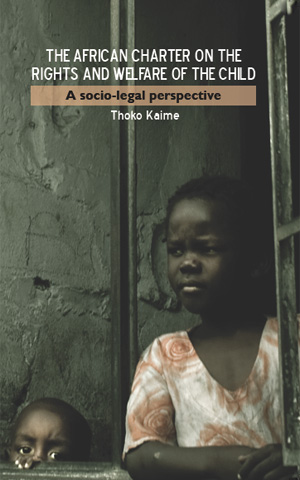The African Charter on the Rights and Welfare of the Child: A socio-legal perspective
by Thoko Kaime
2009
ISBN: 978-0-9814420-4-4
Pages: xii 247
Print version: Available
Electronic version: Free PDF available
About the publication
The African Charter on the Rights and Welfare of the Child is Africa’s pre-eminent document on children’s rights. In this book, Thoko Kaime appropriately locates the Charter at the centre of debates on the promotion and protection of children’s rights. He critically examines the role of law in society as he undertakes a socio-legal examination of the Charter. His analysis of the international mechanisms alongside local cultural processes and observations challenges orthodox views on how best to achieve the realisation of children’s rights within African communities. Raising the cultural legitimacy of children’s rights will require a combination of international, national and local strategies. This book makes the case for such an approach and provides a useful framework for conducting this work.
“It is encouraging to see a scholar who appreciates that rights, even children’s rights, cannot take life if confined to documentation, no matter how august, but to be meaningful, must take root in the social life of communities. It is great to see one who grapples with how this may be achieved.”
- John Eekelaar, Professor of Law, Pembroke College, University of Oxford.
About the editor:
Thoko Kaime Thoko Kaime, is Senior Teaching Fellow in the School of Law. He also serves as Lecturer in international and environmental law in the School of Law at the University of Leicester.
Table of Contents
PREFACE
ACKNOWLEDGMENTS
DEDICATION
TABLE OF CASES AND OTHER LEGAL
INSTRUMENTS
LIST OF TABLES
- INTRODUCTION
1 Background
2 Focus of the book
3 General approach of the book
4 Significance of the book
5 Scope of the book
6 Limitations of the study - THE BIRTH AND DEVELOPMENT OF THE RIGHTS AND WELFARE OF THE CHILD
1 Introduction
2 The structural basis of children’t rights at international law
3 Universal rights and the struggle for context
4 Documents affecting the rights and welfare of the African child
5 Literature on the rights and welfare of the African child
6 Emerging questions - THE AFRICAN CHILDREN’S CHARTER: BEYOND RELATIVISM AND UNIVERSALISM
1 Introduction
2 The concept of culture and its relevance for children’s rights
3 Cultural legitimacy and its relevance for children’s rights in Africa
4 Cultural relativism and the universality of human rights: The debate and its relevance for children’s rights
4.1 Cultural relativism and the relevance of cultural context
4.2 Universalism and human rights
4.3 Mediating between universalism and relativism
5 The implications of the debate for the protection and promotion of children’s rights in Africa - CHILDHOOD AND CHILDREN’S RIGHTS: FOCUSING ON THE BENEFICIARIES OF THE AFRICAN CHILDREN’S CHARTER
1 Introduction
2 The rights and welfare of the child
3 The concept of childhood
3.1 The changing nature of childhood
3.2 The conception of childhood within African communities
4 The relationship between childhood and children’s rights
4.1 The image of childhood underlying the international law of children’s rights
4.2 Children’s rights and the dominant image of childhood
4.3 Obstacles in the export of the dominant conceptions of childhood
4.4 Childhood and the African Children’s Charter
4.5 Consolidating the new image of childhood in favour of the rights and welfare of the African child
5 Concluding remarks - CORE CONCEPTS OF THE AFRICAN CHILDREN’S CHARTER: CONTEXT AND CONTESTS
1 Introduction
2 The general principles and cultural context: The basis for an ethnographic approach
3 Non-discrimination: Concepts, context and contests
3.1 Maybe not good but justifiable: Analysing the pro-distinction narratives
3.2 It is not part of our culture: An inquiry into non-discrimination discourse
4 Best interests: Tracing the contours of a shadow-less concept
4.1 Lost in translation? Conceptualising best interests
4.2 The child’s best interests in family decision making
5 Survival and development and the interrelatedness of children’s rights
5.1 Children’s survival and development: Partnerships and resource networks
6 Participation: A brief introduction
6.1 Adaptation and resistance: A tale of rudeness and freedom
7 Concluding remarks: Children’s rights in cultural practice - CULTURAL LEGITIMACY AND THE IMPLEMENTATION OF THE RIGHTS AND WELFARE OF THE AFRICAN CHILD: INSTITUTIONS AND PROCESS
1 Introduction
2 The formal protection of children’s rights
3 The scope and efficacy of the legal protection of children’s rights and the prospects for cultural legitimacy
4 From the legal to the local: Local institutions and the cultural legitimacy of children’s rights
4.1 Key local institutions in Lomwe country
4.2 The clan
4.3 The chief’s court
4.4 The boma or the district commissioner’s office
4.5 The church
5 Local institutions and the potential for children’s rights protection
6 Incorporating local institutions in the implementation of children’s rights: Process and prospects
7 Concluding remarks - CONCLUDING ANALYSIS
1 Introduction
2 Culture, rights, the African Children’s Charter and the omnipresence of change
3 Cultural legitimacy and the African Children’s Charter
4 Cultural appropriation and the African Children’s Charter
5 The African Children’s Charter in practice
5.1 Dissemination
5.2 Collaboration
5.3 Participation
5.4 Innovation
6 Concluding remarks
APPENDIX A
- African Charter on the Rights and Welfare of the African Child
APPENDIX B
- Convention on the Rights of the Child
BIBLIOGRAPHY
